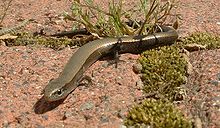Ablepharus kitaibelii
| Ablepharus kitaibelii | |
|---|---|

| |
| Scientific classification | |
| Domain: | Eukaryota |
| Kingdom: | Animalia |
| Phylum: | Chordata |
| Class: | Reptilia |
| Order: | Squamata |
| Family: | Scincidae |
| Genus: | Ablepharus |
| Species: | A. kitaibelii
|
| Binomial name | |
| Ablepharus kitaibelii (
Bory de Saint-Vincent , 1833) | |
| Subspecies | |

| |
| Synonyms[2] | |
| |
Ablepharus kitaibelii,
Geographic range
A. kitaibelii is native to Greece (including the Aegean Islands), Romania, Bulgaria, the former Yugoslavia, Hungary, Albania, Slovakia, the Caucasus, Turkey, Syria, Israel, Jordan, Lebanon, the Sinai Peninsula of Egypt and possibly Iraq. The subspecies A. k. fitzingeri is known from Slovakia, Hungary, Greece and the island of Corfu. The subspecies A. k. stepaneki is known from Bulgaria and Romania. Also Macedonia
Description
A small, slender lizard, A. kitaibelii grows up to 15 cm (5.9 in) in total length (including tail). The skin is bronze-coloured, with dark sides. The eyelids are immovable, in contrast to many other skinks.
Habitat and behaviour
A. kitaibelii is a shy species, which lives under stones and leaves in dry places, such as south slopes, fields, and meadows. It is
Reproduction
Taxonomy
Many former subspecies of Ablepharus kitaibelii have been promoted to categorization as species, such as Ablepharus rueppellii and Ablepharus budaki.
Etymology
The specific name, kitaibelii, is in honor of Hungarian botanist Paul Kitaibel.[3]
References
- . Retrieved 15 April 2023.
- ^ a b "Ablepharus kitaibelii ". The Reptile Database. www.reptile-database.org.
- ISBN 978-1-4214-0135-5. (Ablepharus kitaibelii, p. 142).
External links
- Species Ablepharus kitaibelii at The Reptile Database
Further reading
- ISBN 0-00-219318-3. (Ablepharus kitaibelii, pp. 178-179 + Plate 32 + Map 95).
- Bory de Saint-Vincent [JB] (1833). "Vertébrés a sang froid. Reptiles ". pp. 57-76. In: Geoffroy Saint-Hilaire I, Geoffroy Saint-Hilaire É(1833). Expédition scientifique de Morée. Tome III.—1.re Partie. Zoologie. Paris and Strasbourg: F.G. Levrault. ("Ablepharis [sic] Kitaibelii ", new species, pp. 69-70). (in French).
- Duméril AMC, Bibron (1839). Erpétologie générale ou Histoire naturelle complète des Reptiles. Tome cinquième [Volume 5]. Paris: Roret. viii + 854 pp. (Ablepharus kitaibelii, pp. 809-811). (in French).

